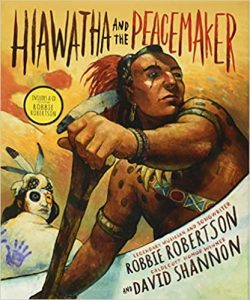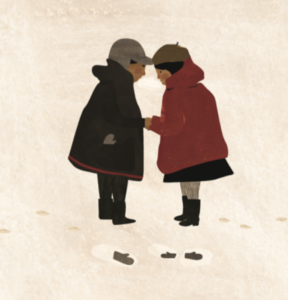Indigenous Perspectives
Hiawatha and the Peacemaker

Author(s): Robbie Robertson & David Shannon
Links:
Amazon: https://amzn.to/3eytShC
Indigo: https://bit.ly/2Ug6Kht
Social Justice focus: Indigenous perspectives
Synopsis: This is a powerful story of Hiawatha, a Mohawk warrior who travels with the Peacemaker to bring peace to the five Haudenosaunee (Iroquois) nations. This beautifully illustrated book contains historical background and a CD of a song written by the author, Robbie Robertson.
Lesson Plan: Mark Diggon
Primary/Junior/Intermediate Lesson Plan (Abbreviated Template)
Consecutive and Concurrent Programs
Unit/Topic: Picture Book – Social Justice
Grade: 8
Lesson: What is the focus of this lesson in relation to the unit?
This lesson starts by focusing on residential schools and the traumas caused by it through out the Aboriginal communities. The focus is family and inter-generational trauma caused by the separation of families. By reading the picture book When We Were Alone, the dialogue about this topic will commence and the conversation can be shifted to modern day atrocities. The class will look at how cultural genocide is prevalent in current times and where in the world families are still being separated and children segregated.
Curriculum Areas: What are possible connections to other curricular areas?
By using the picture book and introducing the topic of Residential Schools, the students can make the connection to the grade 8 history curriculum:
- B3. Understanding Historical Context: describe various significant people, issues, events, and developments in Canada between 1890 and 1914, including the residential school system, and explain their impact (FOCUS ON: Historical Significance; Cause and Consequence)
Curriculum Expectations: What Overall and Specific Expectations will be addressed?
Overall:
Reading
1. read and demonstrate an understanding of a variety of literary, graphic, and informational texts, using a range of strategies to construct meaning
Writing
1. generate, gather, and organize ideas and information to write for an intended purpose and audience
Oral
2. use speaking skills and strategies appropriately to communicate with different audiences for a variety of purposes;
Specific:
Reading
1.6 Extending Understanding: extend understanding of texts, including increasingly complex or difficult texts, by connecting the ideas in them to their own knowledge, experience, and insights, to other texts, and to the world around them
Writing
1.1 Purpose and Audience: identify the topic, purpose, and audience for more complex writing forms
1.2 Developing Ideas: generate ideas about more challenging topics and identify those most appropriate to the purpose
1.3 Research: gather information to support ideas for writing, using a variety of strategies and a wide range of print and electronic sources
Oral
2.4 Appropriate Language: use appropriate words, phrases, and terminology from the full range of their vocabulary, including inclusive and non-discriminatory language, and a range of stylistic devices, to communicate their meaning effectively and engage the interest of their intended audience
2.7 Visual Aids: use a variety of appropriate visual aids to support and enhance oral presentations
Learning Goal(s): What are students expected to know, do and understand? We are learning to….
- Students will be able to explain the purpose of Residential Schools and the reason the Canadian Government built them.
- Students will be able to explain the term inter-generational trauma and expand on its effects.
- Students will be able to explain the term cultural genocide and will be able to identify some major events that have taken place in the past 20 years, including the ones currently happening.
- Students will be able to present and share their findings in a clear and concise manner with their peers. They will also be able to answer the questions of the peers about their topic and expand on the discussion.
Success Criteria: How will students know they have met the learning goal? I can….
- The students will be able to participate in the discussion and conversation in a respectful manner.
- The students will contribute to the group discussions with relevant information, while inferring and sharing their experiences.
- The students will utilize their time efficiently to gather information and put together a presentation.
MODIFICATIONS/ACCOMMODATIONS: How will I meet the needs of my students? Have I addressed any IEPs?
- Reading: the level of the picture book is primary and the teacher will be reading it out loud to the student. Audio books can be provided.
- Writing: the length and the expectations of the letter can be modified to a few sentences.
- Oral: if the student is not comfortable presentation in a group setting, their project can be presented in a one-on-one setting with the teacher. Modifications to the expectations can be made depending on the ability of the student.
- Students can work alone if they are more comfortable in solitary settings.
Minds-on: How will I connect to prior and future learning? How will I engage students and set the context for learning?
Minutes: How much time will I allocate? 15 -20 minutes.
Task: What will I be doing? What will students be doing?

The students will be read When We Were Alone. A discussion will follow with the students about the theme of the book and the message of the author.
Guiding Questions:
- Has your grandmother ever told you stories of her childhood?
- What kind of school was Grandma attending?
- Has anyone heard of residential schools before? If so, what do you know about them?
- Why did the school have regulations such as the ones Grandma talked about?
- What do you think happened to the kids when they went back to their communities?
- How do you think the families felt about their kids attending residential schools?
Assessment: What is the Nature and Purpose of assessment? The assessment for this portion of the lesson will be diagnostic based on the conversation had by the students, and their participation.
Action: How will I introduce new learning / reinforce prior learning / practice learning / scaffold learning?
Minutes: How much time will I allocate? 45 minutes (the students will start this activity and will continue during the following class).
Task: What will I be doing? What will students be doing?
The students will work in groups of 3-4 and will be given photographs of Grandmothers. These photographs will be from all over the world. They will be asked to write down a paragraph length story from the Grandma’s perspective. This will be done by assessing the photograph.
Guiding questions:
- What decade is this photograph from?
- Where in the world is she from?
- What does her expression tell you?
- What stories does she look like she would have to share?
The students will then share their stories with the class. Once they have done that, the teacher will inform the student of the exact heritage and the age of the Grandmother. The students creativity and efforts will be celebrated before introducing the following topic: ‘Cultural Genocide’. This will be written on the board and the students will share what they think or what they know this means in a POPCORN manner (each table sharing an idea while the teacher write them down).
The students will then re-group in pairs and commence a research session to find out exactly what kind of stories this Grandmother would have to share. The ethnicity of the Grandmothers will be linked directly to cultural genocides that have taken place in the past 20 years. (SEE ATTACHED SHEET OF PHOTOGRAPHS AND DESCRIPTIONS).
Assessment: What is the Nature and Purpose of assessment? Formative assessment will take place during this section of the lesson. This will be a conversation based session where the students will be given their learning goals and their success criteria and will be guided in achieving these.
Consolidation: How will I reflect on the learning goal? How will I have students reflect on the learning goal?
Minutes: How much time will I allocate? 45 minutes
Task: What will I be doing? What will students be doing?
The students will have this time to put together a mini presentation about their findings. They will at this time have been given the basic information about the Grandmothers in the photographs and will have had the time to research how their lives would have been affected by the cultural genocide taking place in their country. The students will present their findings with a five slide PowerPoint presentation which will address the following questions:
- What country is this Grandmother from?
- What ethnicity is she?
- What year did a cultural genocide take place in her county? And by whom?
- What was done about it by the international committee?
- What is the status of her people in present day?
- These presentations will guide the students to the final concluding question of the lesson: what can we do about these issues, and how can we bring about change?
Assessment: What is the Nature and Purpose of assessment? The assessment for this presentation will be summative. The students will have had access to the learning goals and the success criteria from the previous session, and they will have access to a copy of an assessment rubric clearly outlining the expectations of each level (levels 1-4)
MATERIALS: What resources and materials do I need? Where can I find them? In a perfect world what other resources might I need?
- Picture book: When We Were Alone, by: David Robertson
- Writing utensils – pen, pencil, paper
- Photographs of Grandmothers – provided by the teacher
- Access to computers and/or tablets (and internet) to do research and put together a PowerPoint presentation
Hiawatha and the Peacemaker Exit Card
What does the Hiawatha Wampum Belt and the Haudenosaunee mean to you with regards to bullying and conflict resolution?________________________________________________________________________________________________________________________________________________________________________________________________________________________________________________________________________________________________________________________________________________________________________________________________
Hiawatha and the Peacemaker Exit Card
What does the Hiawatha Wampum Belt and the Haudenosaunee mean to you with regards to bullying and conflict resolution?________________________________________________________________________________________________________________________________________________________________________________________________________________________________________________________________________________________________________________________________________________________________________________________________
Hiawatha and the Peacemaker Exit Card
What does the Hiawatha Wampum Belt and the Haudenosaunee mean to you with regards to bullying and conflict resolution?________________________________________________________________________________________________________________________________________________________________________________________________________________________________________________________________________________________________________________________________________________________________________________________________

